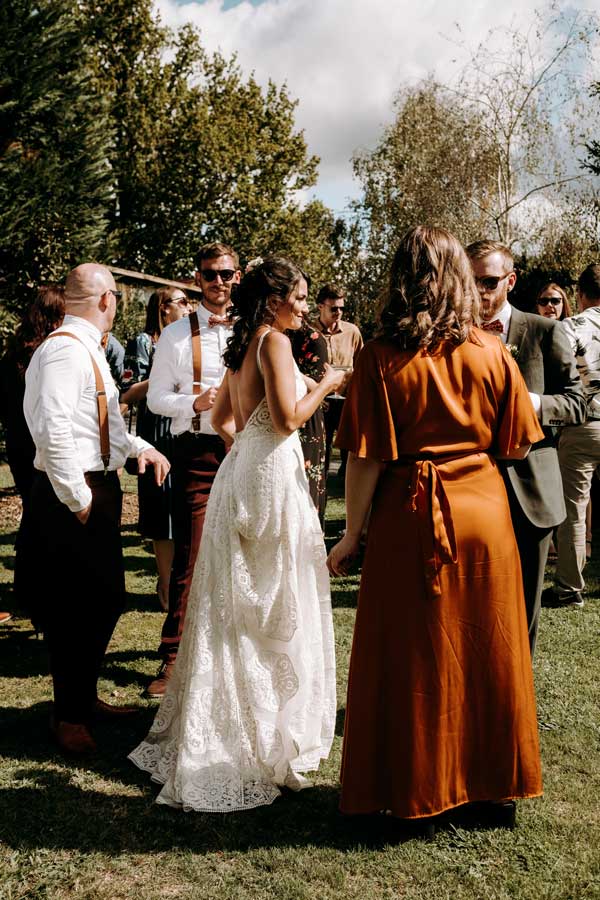Congratulations! You’re getting married! You have your wedding location and reception all booked. You’re on the hunt for the dream wedding dress and you know exactly what you want – the style, silhouette, fabric, accessories etc. While you search for (or design) the perfect wedding dress, do consider the addition of a bustle for it. Especially if you are considering a wedding dress with a long train, bustling the dress is an important detail that you should definitely consider having done, as you tick items off your wedding dress to-do list.
What is a bustle?
Simply put, a bustle is a fastener or a set of fasteners attached to your gown. While historically, bustles were added to gowns to accentuate the womanly figure, modern bustles are primarily used to shorten the length of your wedding dress train so that the front and back hemlines are kept uniform. This is especially useful for wedding gowns with a long train, as it keeps the hemline of your dress from getting dirty and allows ease of movement for the bride (you don’t have to worry about tripping up on your gown or worse, tearing the fabric and ruining your wedding dress!). A wedding dress bustle is fastened after the wedding ceremony so that the bride is able to move around freely during the wedding reception and afterparty.
Historically, the bustle was a padded undergarment that was in popular use during the Victorian era (mid to late 19th Century), in both European and North American women’s fashion. Bustles were originally worn low and fanned out to expand the skirt beneath the waist in order to create fullness to the back of the dress and a flowing train. A full, rounded posterior following a slim waist was considered the ideal figure for a woman and thus this padding helped the woman attain the much sought-after silhouette. Bustling a woman’s gown went out of fashion in the late 1880s and has remained out of fashion since. Except of course, in its modern form in haute couture and bridal gowns. Unlike its predecessors, the contemporary bustle does not involve additional padding underneath the garment, but rather a set of fasteners attached to the gown itself. Its purpose has also evolved from a purely aesthetic function of emphasising a woman’s posterior into a practical and aesthetic means of shortening the dress train.
Do I need a bustle for my wedding dress?
In order to figure out if you need a bustle for your wedding dress, ask yourself if your wedding gown has a train. If your answer is yes to that, ask yourself the following questions as well –
- Am I wearing the same wedding dress for both the ceremony and wedding reception/afterparty?
- Is my wedding and/or wedding reception going to be held outdoors?
- Will I be dancing and moving around a lot?
- Will there be lots of guests and potentially young kids at the wedding reception?
If your answer is yes to some or all of the above questions then, YES! You do need a bustle for your wedding dress.
Why are bustles useful in wedding gowns?
There is a very high probability for wedding gowns with trains tend to get stepped on or get dirty as they get dragged on the ground. It is also possible for the wedding gown to get ripped or damaged in any number of ways during the wedding reception, especially if the train is long. Thus, unless your wedding dress is short or tea-length, it is definitely a good idea for you to bustle the dress to allow for freedom of movement whilst you mingle with the guests or bust out your signature moves on the dance floor.
As useful as it is, the bustle is not included in most wedding dresses that you buy off-the-rack as the having the right bustle depends on various factors such as your height and personal style, the silhouette of your wedding gown and the fabric, as well as the wedding location. Should you need one for your wedding gown, a wedding dressmaker or a bridal alteration specialist would be able alter it by adding buttons, loops, hooks and eyes or even ribbons for the bustle.
What are the different types of wedding dress bustle types?
There are several different types of bustles, but they can be broadly categorised into two main types – the under bustle and the over bustle. The under bustle is made up of fasteners attached to the train in such a way that the train is attached to the underside of the gown, while the over bustle is made up of fasteners attached to the top of the train to allow the train to drape over the gown. Read on to find out more about the various types of bustles and which wedding dress style each one is best suited for.
American Bustle (Traditional or Over Bustle)
This bustle style is also sometimes referred to as the traditional or over bustle. It is also the most common type of bustle used, the most simple and usually the most affordable option for your seamstress to sew on your wedding gown. This style simply involves lifting the train up and fixing it to the outside of the gown and securing it near the waistline at a point. As the fabric is gathered up and fastened over the rest of the skirt it results in a beautiful cascade of folds. Depending on the length of the train and the weight of fabric, this bustle may require either one or several pick up points to be secure.
Best suited for : Ballgowns, mermaid, sheath and A-line gowns, especially dresses with long trains (eg. Cathedral trains) and gowns with lightweight fabric such as lace and tulle.
Pros: Adds flexibility to the style as the bride can decide on either a simple but statement one pickup point or multiple pickup points for dramatic effect. It is the simplest and most affordable type of bustle.
Cons: Not particularly suited for dresses with heavy fabric. The bustle points are on the outside of the dress and so will be visible on plain fabrics.
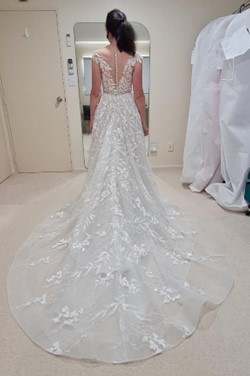
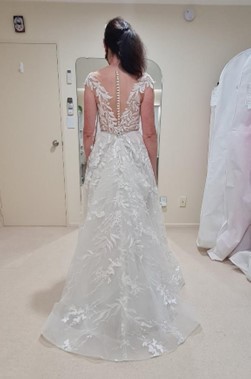
French Bustle
The French bustle is a beautiful under-bustle that is secured by hooks, buttons or ribbons on the inside of the dress. It is a more secure type of bustle and usually requires multiple pickup points for the train of the dress to be folded and attached to. The train is folded under itself and tucked in, creating a layered and more voluminous look for the skirt. As the fasteners are hidden under the skirt the end result is more elegant and understated. This type of bustle is more suited for gowns with less detailing below the waistline as any decorative elements present there will be hidden in the folds of the bustle. It’s also a good option for mermaid and trumpet style wedding gowns and dresses with shorter trains.
Best suited for: A-line or sheath dresses with shorter trains, mermaid and trumpet style dresses and dresses without a defined waistline. Suitable for dresses with heavy fabric.
Pros: Very secure, with multiple pickup points. Elegant and classic style.
Cons: Complicated to install and fasten. More expensive option. Not suitable for ballroom gowns.
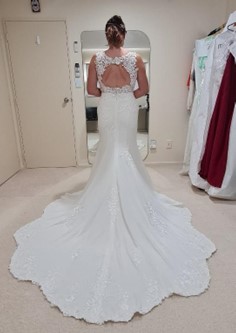
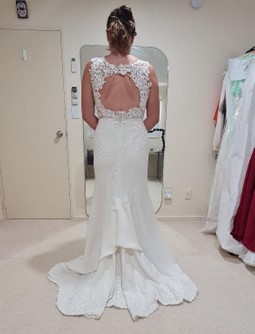
Ballroom Bustle
A ballroom bustle is one of the most complicated bustles to create as it is an under-bustle structured with multiple pickup points across the waist or lower part of the skirt. Your skilled alteration tailor would install either buttons or hooks at various points along the pick-up points and on the train of the dress. When each of these points is carefully, and delicately fastened, the train virtually disappears and it looks as if your dress is actually a floor-length dress! For brides who want to hide the train entirely for the reception and create the illusion of wearing two separate dresses on their wedding day and reception, this is the ideal bustle to have. It is also a very secure bustle thus making it perfectly safe for you to twirl around on the dance floor to your heart’s content. Bear in mind though, as there are multiple pleats created with this type of bustle, your dress will appear to have a fuller skirt once the bustle is fully fastened.
Best suited for: All dress styles, and ball gowns in particular. Suitable for dresses with heavy fabric due to multiple pickup points making it very secure.
Pros: Creates the illusion of two separate dresses. Does not change the look of the dress. Flattering with any dress silhouette.
Cons: Complicated to create, making it more expensive. Also complicated to fasten.

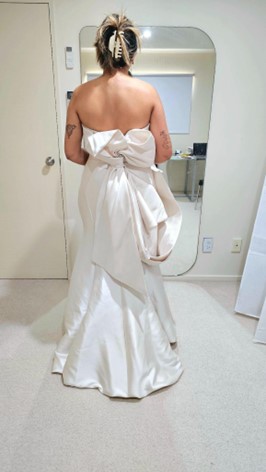
Bow Bustle
If you want an elegant look with some dramatic flair, then the bow bustle is for you. Perfect for gowns with a statement bow at the back or a sash, the bow bustle is an over bustle much like the American bustle, but created by folding the train over the gown and securing it with ribbons or ties hidden underneath the bow or sash. This brings attention to the back of the dress and highlights the beautiful features there. It’s particularly flattering on A-line wedding gowns and those with full skirts and tulle fabric.
Best suited for: A-line dresses, gowns with full skirts.
Pros: An elegant and relatively easy to attach bustle.
Cons: Not suitable for several dress styles such as ballroom gowns

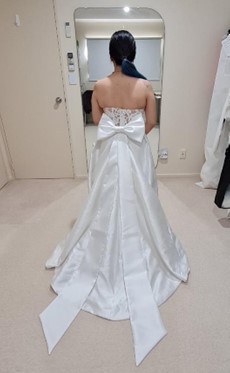
Royal (or Victorian Bustle)
The royal or Victorian bustle is a vintage-inspired, eye-catching and elaborate over bustle that is particularly suited for ballroom gowns. A skilled seamstress would affix multiple pickup points across the back of the dress to create multiple dramatic folds. Traditionally, ribbons are attached at the pickup points to hide the attachments and to create a more natural look. This is a statement bustle and one that is gaining in popularity amongst brides who wish to have their own “Beauty and the Beast” fairytale moment on the dance floor. Your gown should have a full skirt or long train as lots of fabric is needed for this style to look good.
Best suited for: Ballroom gowns and gowns with very full skirts or dresses with long cathedral length trains.
Pros: Statement and attention-grabbing design. Secure with multiple pickup points for long trains and full skirts.
Cons: Complicated option for both tailoring and fastening. More costly option. Not suitable for more streamlined skirts or shorter train lengths.
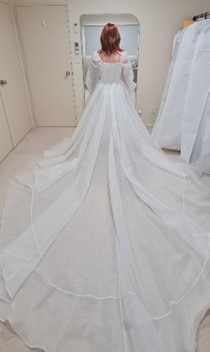

Austrian Bustle
An Austrian bustle is the most unique style of bustle. This is done by gathering together the excess fabric from the train onto an internal cord and ruching it to create cascading folds of fabric on either side of the cord. This drawstring type of bustle can be created either in the center back seam or on multiple places on the train to create multiple draping folds. This style of bustling is easy for the bride to use as it just requires pulling on the drawstring to lift the train. However, it is more complicated for the seamstress to create the Austrian bustle and therefore, more expensive to tailor. The result though, is a truly unique and intricate looking bustle that is sure to make a statement!
Best suited for: Wedding dresses with a fitted bodice and train with fabric such as silk, silk crepe or satin. Also suitable for gowns with intricate detailing, beading, appliques and lace on the skirt.
Pros: Easy to use. Creates a statement with its unique, ornate design.
Cons: Complicated to install, thus more expensive.
Wrist Loop or Finger Loop Bustle
The wrist loop/wristlet or finger loop bustle, is one of the simplest and elegant wedding dress bustling options. It only involves taking the tip of the train and fastening it to a loop that goes around your wrist, making it easy to tailor and therefore more affordable. This looks very lovely, especially on the dance floor with the dress flowing and billowing about the bride as she twirls. However, as you can imagine, it can put some strain on the wrist or finger after awhile and is thus not particularly suited for dresses with heavier fabric or longer trains. This option also means you have to carry the train the entire night, so if you love holding your champagne glass, be wary that your dress train will also be in your hand.
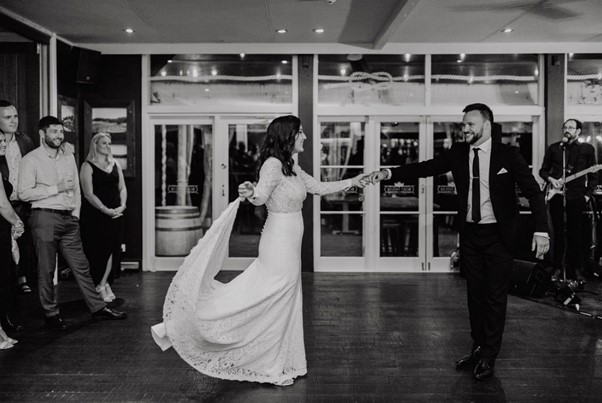
Best suited for: Dresses with more modest trains and lightweight fabric. Dresses made with silk or satin would look especially lovely and flowing.
Pros: Simplest option for tailoring and fastening. Very affordable.
Cons: Not suited for dresses with heavier fabric, fuller skirts or longer trains. Bride has to carry the train the entire reception.
What do I need to know before I choose the right bustle for my bridal gown?
There are a number of factors to consider when choosing the right type of bustle for your wedding gown. But first, you’ll need to source for a skilled dressmaker who is able to do the right alterations on your dress and who will ensure that the altered dress looks great and fits you perfectly with and without the bustle. This is very important as you want to look your best at both the wedding and reception so the dress has to look flattering on you with the bustle as well! When you meet your dressmaker, he or she will be able to recommend the best bustle style for you based on the following factors –
- Your dress style and silhouette
- Your height and body type
- The length of the train
- Dress fabric
- Your budget (the more complex the bustle, the higher the cost is likely to be)
- The location of your wedding and reception
What does a wedding dress look like before and after bustling?


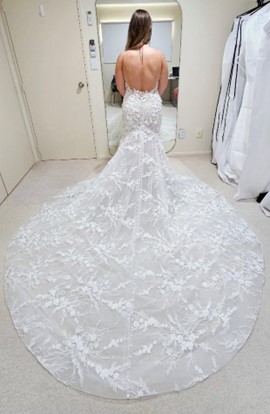
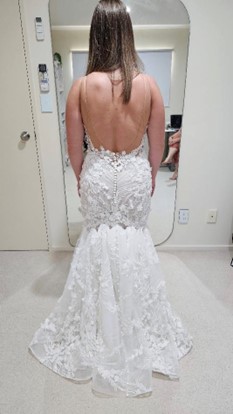
Final tips on wedding dress bustling
Make sure you have someone reliable on your wedding day to help
No matter the type of bustle you choose, be it simple or more complicated to attach, you are going to need a helping hand with the bustling. It is almost impossible to do the bustling yourself as apart from the wrist loop bustle, most others require fastening the train at the back of your dress. You are definitely going to need someone to correctly fasten each loop, button, ribbon or hook and to ensure that the end result looks good. Therefore, choose a reliable helper and bring the person (or persons) along on your final dress fitting so that they can learn how it’s done properly. It is also good if you can squeeze in a test run or two before your wedding day, so your helper and you can get used to the process. You want the process to be as smooth as possible so nerves don’t get in the way of you looking your best.
Be prepared for the worst
No matter how many test runs you do and how well the dress is secured, accidents can happen. No bustle is foolproof. The heavier the fabric or longer the train, or even the more physical the activity your dress has to go through, the more likely it will be for one or more of the fasteners to break or come undone. Have some heavy duty safety pins ready and even some strong thread and needle for emergency repairs if needed.
Whatever dress style you choose, if your wedding dress has a train then a bustle is definitely recommended for it. Hopefully, after reading this handy guide on bustles, you now have a better idea about bustles and what type of bustle would best suit you (plus a few handy tips on how to bustle).

